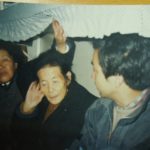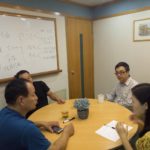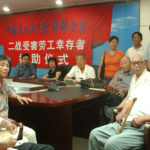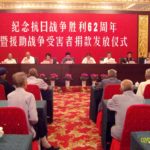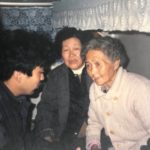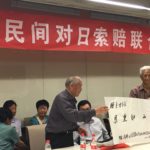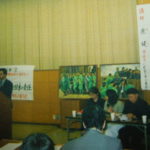THE BATTLE OF CHINA focuses on Japan’s invasion of China. Special attention is paid to the history of China and the origins of the conflict, including Japan’s “Tanaka Memorial” plan for conquest. A moving, human portrait of a nation beset by tragedy, the documentary highlights the grim determination of the Chinese, who lose battle after battle yet stay in the fight.
The atrocities that the Japanese Imperial Army inflicted on China, Korea, Philippines, and other parts of Asia during WWII were not isolated incidents, but massive atrocities that included the Nanking Massacre, sex slaves, biological and chemical warfare, and slave labor.
The Nanking Massacre:During the six-week period beginning on December 13, 1937, about 300,000 Chinese (mostly civilians) were killed, over 20,000 Chinese females (women, girls, and even very young girls and great-grandmothers) were raped, and one-third of the city of Nanking was burned to the ground. Many Chinese were beheaded or bayoneted in competitions among Japanese soldiers to see who could kill the most. Many were lined up and shot en mass, or were buried alive in mass graves. The Yangtze River was a river of death with dead bodies floating all over, and Nanking ran out of coffins.


The woman still clutching baby even though her head had just been cut off.


A field of severed heads.
Sex Slaves(or euphemistically called “comfort women” by the Japanese government):
Approximately 400,000 women and young girls from China, Korea, Philippines, Netherlands, and other countries (with about 50% being Chinese) were forced to become sex slaves to the Japanese soldiers occupying China, Korea, Burma, Philippines, and other parts of Asia.2 Most of these women and girls were kidnapped from their families and shipped to all over the Japanese empire to become sex slaves, and many died or were never united with their families again. Sometimes, these women and girls were tricked to become sex slaves when they thought they were being recruited for other jobs. As sex slaves, they were raped on a daily basis by as many as two dozen or more Japanese soldiers, while being poorly fed and living in extremely harsh conditions.


Many women were forced to become sex slaves.


A gang-raped woman was killed and had her stomach split open.
Biological and Chemical Weapons of Mass Destruction:Thousands of biological and chemical weapons were used by the Japanese army in Heilongjiang, Hunan, Jiangsu, Jilin, Guangdong, Yunnan, Zhejiang, and other provinces in China. The largest Japanese biological/chemical warfare laboratory, Unit 731, near Harbin, Heilongjiang, is probably the largest such laboratory ever in the world. Unit 731 was a gigantic complex covering six square kilometers and consisted of more than 150 buildings, with living quarters and amenities for up to 3,000 Japanese staff members, 300-500 of whom were medical doctors and scientists. The complex contained various factories. It had 4,500 containers for raising fleas, six giant cauldrons to produce various chemicals, and around 1,800 containers to produce biological agents, such as those associated with cholera, bubonic plague, and anthrax. Approximately 30 kg of bubonic plague bacteria could be produced there in several days. An example of such biological (germ) warfare occurred on May 4, 1942, when Japanese airplanes dropped cholera and bubonic plague-infected bombs in the city of Baoshan in Western Yunnan that killed about 60,000 people in the Baoshan area from cholera, and thousands more were killed from the bubonic plague. The population of Baoshan In 1942 was about 400,000.
Many terribly painful life-long rotten leg infections were caused by glanders used by the Japanese military during WWII.


Photo of the legs of a victim of glanders attack in 1942 in Zhejiang Province.
Note: At the 27th General Assembly of The Japan Medical Congress in Osaka, a segment of the Japan Medical Congress organized a big exhibit on “War and Medicine” that reflects on the morality of Japanese medicine as practiced by Japan’s biological/chemical warfare research centers and factories. More information can be found:
- For Japanese article: Japanese_panel
Slave Labor:The number of slave laborers in Asia forced by the Japanese Imperial Army was huge. According to an official report from the Japanese Ministry of Foreign Affairs dated 1946 when Japan had already lost the war and was trying to erase or at least reduce the magnitude of her crimes, there were 40,000 Chinese forced laborers in Japan, which was probably an underestimate by an order of magnitude. Since most of the Chinese forced laborers were working in various parts of China, and not Japan, the number of Chinese forced laborers could easily run into millions.5
Prisoners of war (POWs) of the Japanese Imperial Army during WWII were consistently mistreated. Torture, slave labor, and execution were common. There were numerous incidents, including not only Chinese but also soldiers from Western countries such as the U.S. This occurred during the previously mentioned Nanking Massacre when thousands of Chinese soldiers were summarily executed whenever they were captured. Another incident occurred in the aftermath of the Japanese troops defeating the American and Filipino troops after the 99-day Battle of Bataan in the Philippines on April 9, 1942, which was the largest defeat in U.S. military history. The end of the Battle of Bataan marked the beginning of one of the cruelest episodes in the history of modern warfare, the little known Bataan Death March.


Photo of Bataan prisoners from: http://www.battleofbataan.com/photos.html
(this site contains many other photos)
Why does Change need to Happen? In spite of the large scale and seriousness of these atrocities, the Japanese government still has not formally acknowledged the atrocities their Imperial Army committed about 70-80 years ago. This long amnesia of war crimes of such magnitude is a great stumbling block to ultimate peace and reconciliation among the Asian countries, and the world at large. That is why improving the education of this part of history is especially important today when students everywhere need to become world citizens. For the sake of our children and grandchildren getting a correct perspective on history, this state of affairs must change.
Footnote 1: See article “Nanking Massacre: An Eyewitness Account” in http://www.nj-alpha.org/Reference_Information_Articles/HTML_Articles/Chang_Chu_Yeh_English.html
Footnote 2: These are the most recent estimates based on more than 20 years of investigation by the world’s foremost expert on the sex slaves issue, Professor Zhi Liang Su (and his team), who is the Director of the Comfort Women Research Institute at the Shanghai Normal University in Shanghai, China. Earlier corresponding numbers from the United Nations were 200,000 sex slaves, with the majority being Koreans.
Footnote 3: http://democrats.foreignaffairs.house.gov/110/kim021507.htm
Footnote 4: http://www.dontow.com/2009/08/heroic-and-critical-battles-in-yunnan-during-wwii/
Footnote 5: http://www.dontow.com/2014/09/reflections-from-2014-peace-reconciliation-asia-study-tour/
Footnote 6: http://www.globaltimes.cn/content/850227.shtml
Footnote 7: See article “American POWs and the Bataan Death March,” http://www.dontow.com/2009/06/american-pows-and-the-bataan-death-march/




